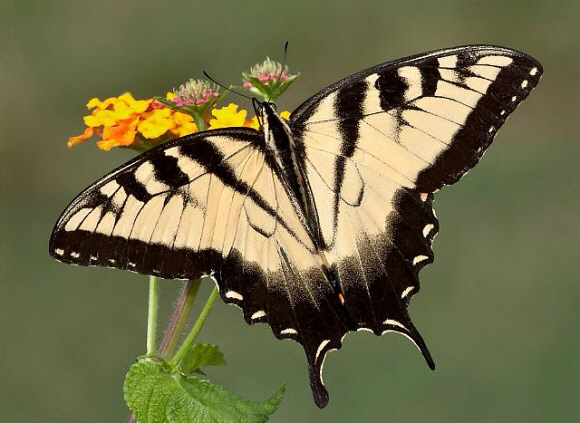Introduction
Back in the 18th century when Linnaeus created the System Naturae, the word Papilio was used as the genus name for every known species of butterfly in the world. Since then much has been learnt about the relationships between different species. Consequently most have been reassigned to new genera, and only about 215 of the 17600 currently known species are retained in Papilio.
There are 30 Papilio species in the Australian region, 60 in the Oriental region, 40 in the Holarctic region and 54 in Africa. The taxonomy of North and South American ‘Papilio’ species has recently been revised, with the effect that almost all South American species and several North American species have been transferred to Heraclides, or in the case of glaucus to Pterourus.
Pterourus glaucus is one of several species that share the tiger pattern of black stripes on a cream background. Only the males have the tiger pattern – females are plain chocolate brown on both wing surfaces. They have a series of submarginal cream coloured crescents on both wings, and on the hindwings also have a series of post-median blue crescents, and red anal and apical spots.
Four of the remaining “tiger” swallowtails – canadensis, appachaliensis, alexiares and rutulus were once considered to be subspecies of glaucus, but are now recognised as true species.
P. glaucus is restricted to the central and eastern states of the USA.
Habitats
This species is found in open deciduous woodland, at altitudes between sea level and about 1000m.
Lifecycle
The eggs are greenish-yellow, speckled with brown. They are laid singly on leaves of the foodplants which include Prunus, Crataegus, Malus ( Rosaceae ), Populus ( Salicaceae ), Acer ( Aceracaea ), Tilia ( Tiliaceae ), Carpinus, Alnus ( Betulaceae ), Liriodendron ( Magnoliaceae ) and various other trees and shrubs.
The caterpillars when small are dark brown above, greyish below, and are marked with a white dorsal saddle. When at rest on the upperside of leaves they greatly resemble a bird dropping.
When fully grown the caterpillars are plump, mid-green in colour, and have a series of small blue dorsal and mid-dorsal spots. On the 3rd thoracic segment there is a pair of yellowish ocelli, each with a black “iris” and a central white “reflection” mark. If the caterpillar is molested it hunches up, causing the ocelli to expand and take on a threatening appearance which probably has the effect of deterring avian and mammalian predators. If molested further, the larva produces from behind it’s head an eversible fleshy orange forked structure called an osmaterium, which emits pungent chemicals. Experiments with captive birds have demonstrated that the chemicals are ineffective against them, but they are capable of deterring ants, and predatory / parasitic wasps and flies.
The chrysalis is light brown, mottled with olive or black, with a brown lateral stripe and a pale dorsal stripe. It is attached by the cremaster and a silken girdle to a woody stem, tree trunk, or to broken twigs or dead leaves on the ground. The pupae hibernate overwinter.
Adult behaviour
Males patrol back and forth along roadsides and woodland rides in search of females, and in hot weather aggregate in groups of up to 20 to imbibe mineralised moisture from damp ground. They also feed at carrion and dung. Both sexes nectar at Lantana and many other wild flowers.

